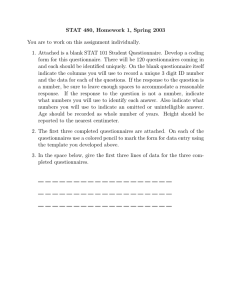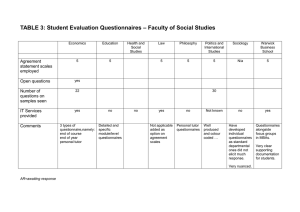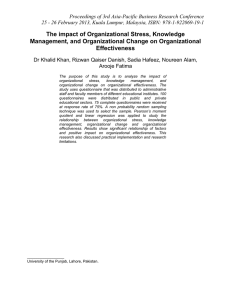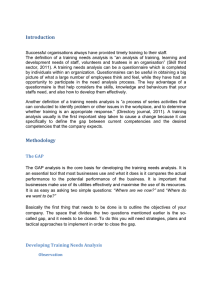UNIVERSITY OF WARWICK on Friday 20
advertisement
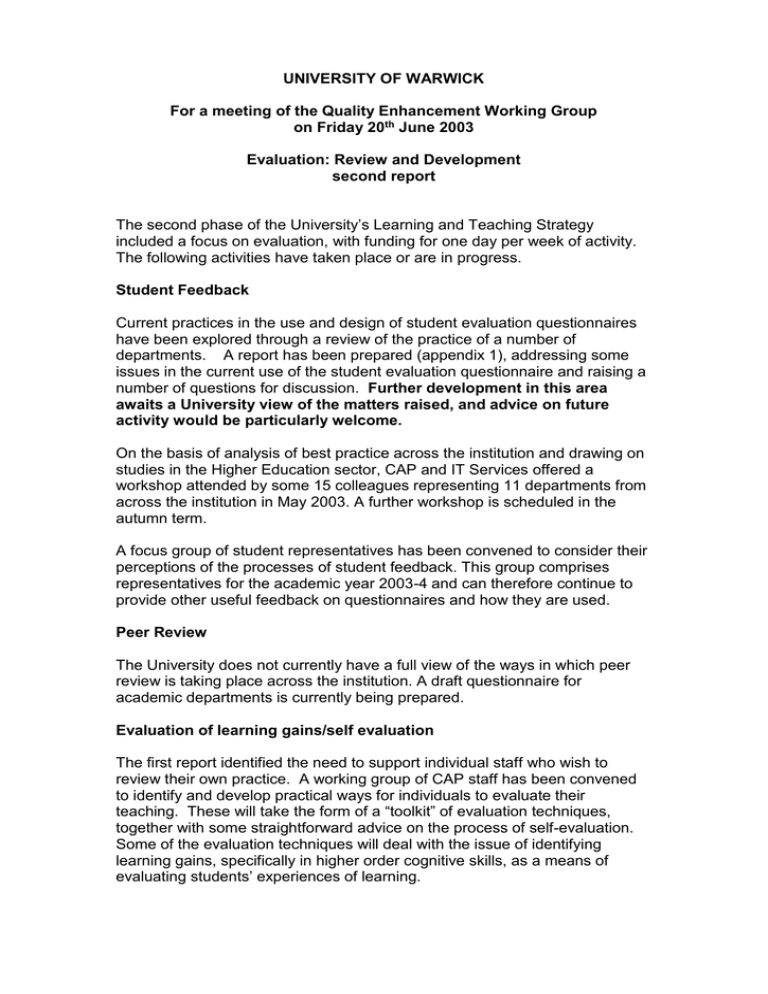
UNIVERSITY OF WARWICK For a meeting of the Quality Enhancement Working Group on Friday 20th June 2003 Evaluation: Review and Development second report The second phase of the University’s Learning and Teaching Strategy included a focus on evaluation, with funding for one day per week of activity. The following activities have taken place or are in progress. Student Feedback Current practices in the use and design of student evaluation questionnaires have been explored through a review of the practice of a number of departments. A report has been prepared (appendix 1), addressing some issues in the current use of the student evaluation questionnaire and raising a number of questions for discussion. Further development in this area awaits a University view of the matters raised, and advice on future activity would be particularly welcome. On the basis of analysis of best practice across the institution and drawing on studies in the Higher Education sector, CAP and IT Services offered a workshop attended by some 15 colleagues representing 11 departments from across the institution in May 2003. A further workshop is scheduled in the autumn term. A focus group of student representatives has been convened to consider their perceptions of the processes of student feedback. This group comprises representatives for the academic year 2003-4 and can therefore continue to provide other useful feedback on questionnaires and how they are used. Peer Review The University does not currently have a full view of the ways in which peer review is taking place across the institution. A draft questionnaire for academic departments is currently being prepared. Evaluation of learning gains/self evaluation The first report identified the need to support individual staff who wish to review their own practice. A working group of CAP staff has been convened to identify and develop practical ways for individuals to evaluate their teaching. These will take the form of a “toolkit” of evaluation techniques, together with some straightforward advice on the process of self-evaluation. Some of the evaluation techniques will deal with the issue of identifying learning gains, specifically in higher order cognitive skills, as a means of evaluating students’ experiences of learning. Contacts in two departments have expressed an interest in developing their approaches to evaluation. Discussions to commence this work are scheduled for late June 2003. Project Evaluation A process for evaluating Teaching Development Fund projects has been devised and adopted by the University’s Teaching Development Fund Committee. Discussions have taken place with a number of award winners on this aspect of project design. Evaluation by CAP colleagues of currently funded projects will commence, using this process, as projects develop and complete. A presentation on developing e-learning was made, with the Head of Educational Technology in CAP, to a Law School IT Away Day. Other Evaluation Issues A process of course review for the Warwick Teaching Certificate has been refined to develop issues arising from the questionnaire into structured meetings with participants, to develop sophisticated responses to issues emerging through both module evaluation questionnaires and course evaluations. These meetings are occurring in the weeks 9th June-27th June. Teaching Promotion The University has in recent years adopted procedures and criteria for promotion partly on the basis of teaching excellence. Candidates are asked to produce a teaching profile showing their excellence. The evaluation processes and criteria have been refined and developed in response to the applications and the issues they raise. Regular sessions are offered to potential promotion candidates and to Professors Responsible on the preparation and assessment of teaching profiles. Warwick Award for Teaching Excellence During 2003 the University made its first awards for teaching excellence, on the basis of profiles submitted on behalf of members of academic staff by colleagues and students. Assistance was offered to the assessing panel on assessment criteria and their use. Further development Activities for July-December 2003 will be agreed following the meeting of the Quality Enhancement Group in June. Piers Nicholls Centre for Academic Practice June 2003 The uses of the student evaluation questionnaire at the University of Warwick 1. Purpose of report The University’s Learning and Teaching Strategy 2002-2005 referred to the importance of teaching evaluation, particularly in relation to academic staff promotion. “The recognition of teaching achievements in the promotions process necessarily leads to the requirement for the introduction of more robust mechanisms for monitoring and evaluating teaching quality. Resources will be allocated...to review current practice in teaching evaluation, develop evaluation practice, introduce and trial evaluation tools and provide support and guidance for staff.” Whilst evaluation comes in many forms, this report focuses on perhaps the most common and well-embedded form of evaluation, the student feedback questionnaire. The report reviews the national context for student evaluation and current practice at Warwick before making recommendations on what appear to be more straightforward points and raising a number of more problematic issues for discussion. 2. National context Student evaluation questionnaires are used at most Higher Education Institutions. They provide an economical means of gaining feedback from student on their perceptions of the quality of teaching provision and of their learning. As such they have considerable potential for improving the quality of teaching and learning, at the level of the individual teacher or course, and it is at that level that they have been most widely used. In addition, they are used at most Higher Education Institutions as part of quality assurance processes and the data arising for their usage will often provide evidence in QAA review and audit processes. Subject Overview Reports1 provide evidence on a subject to subject basis of the weight and importance placed on this type of evidence and the quality of how institutions respond to issues raised. The process of developmental audit maintains the importance of student feedback and therefore the need for carefully considered and well-designed questionnaires remains. In the recent White Paper2 the Government indicated a desire to undertake a broad survey of students’ views (in partnership with the NUS) to inform a Guide to Universities. The future direction of this initiative is not fully clear. However, it seems likely that universities will need to consider the probability that such surveys will be undertaken, and that the publication of results from such surveys might be of wide public interest. This view is further supported in 1 http://www.qaa.ac.uk/revreps/sujrev/overviews.htm 2 http://www.dfes.gov.uk/highereducation/hestrategy/teaching.shtm the publication of the Cooke Report3 which proposes a template for publishing the results of student feedback4. A further consideration in the development of student questionnaires arises from current policies to widen participation. As the educational, social and cultural background of students change, there may be the need to find out, in greater detail than currently emerges from course-based questionnaires, how the experiences of these students are affected by the learning and support environment of an institution. 3. Basis of report To date, there has not been a comprehensive audit of all practices across the institution. In order to appraise the current use of the student evaluation questionnaire, and for the purposes of this interim report, samples of seven departmental questionnaires were considered. In addition detailed discussions were undertaken with IT Services (who provide data analysis of some departmental questionnaires), the Education Officer of the Student Union and three departmental contacts. Additional information was sought from currently published minutes of Staff-Student Liaison Committees, the Quality Handbook and the Chair’s Handbook. 4. Current practice at Warwick Student evaluation questionnaires are currently used throughout the University as part of the delivery of the institution’s taught courses.5 The University has a clear and unambiguous commitment to students’ views stated as, “The University takes the view that it is essential to ensure there are effective methods in place for assessing student opinion”6 Student questionnaires are a departmental responsibility. There has been very clear and comprehensive guidance provided to Departments on the preparation and use of student evaluation questionnaires. These guidelines are reproduced in the Chair’s Handbook. Departments have designed and developed their own questionnaires and consequently they vary in format, design and purpose across the University. While most departments use paper-based questionnaires, some departments 3 Information on Quality and Standards in Higher Education, HEFCE, 02/15 A format for questionnaire design might follow a modified rubric set out in Annex D of the Cooke Report. The broad structure would be: A) Academic and tutorial Guidance B) Quality of teaching C) Range and appropriateness of learning and teaching methods D) Usefulness and promptness of feedback on assessments E) Quality of learning resources F) Quality of accommodation etc.) Quality of pastoral support 5 The Graduate School produces a questionnaire for research degree students; However, this has not been considered as part of this report. 6 http://www.warwick.ac.uk/info/quality 4 have developed web-based formats. Most student evaluation questionnaires currently used are summative in that they survey students’ responses once a course or module has been completed. There is evidence of good practice in using formative evaluation, during the delivery of a course, to provide feedback while a course is being delivered. It is likely that by undertaking their own design of the questionnaires, departments will develop a strong sense of ownership. It also means that evidence coming out of the completed questionnaires varies in quality and quantity between departments and therefore cannot, in the current circumstances, reliably be compared. 4. Design issues A brief survey of the available questionnaires reveals the variety of approaches currently adopted in their design. Some examples drawn from actual questionnaires show a range of approaches: - Example 1 How intellectually stimulating was L? poor /adequate/average/good/V good Example 2 By the end the purpose and direction of the course were clear/hazy/unclear Example 3 Objectives of Lectures clear unclear 7 6 5 4 3 2 1 Objectives These three examples show the different styles, scales and language employed in the University. In spite of the range of approaches taken in designing questionnaires, there are common areas covered (albeit framed differently) across the spectrum of subject disciplines. Some questions focus upon individual lecturer performance, while others concentrate on the student experience of learning. Data may therefore relate either to teaching or to learning or both. 5. Distribution, collection and analysis of student evaluation questionnaires As with issues of design, practice varies across the University. Dept A Dept B Dept C Dept D Dept E Dept F Dept G As demonstrated in the table, some departments state at the beginning of the questionnaire, the purpose and use of it. Some departments emphasise that the responses are anonymous. The Questionnaire clearly explains its context and purpose x x x The Questionnaire indicates that the students’ view are provided anonymously x x x x x x The judgement scale used in Agreement statements 3 7 5 5 5 3&5 5 There is space provided for more open comment IT Services provide a scanning and data analysis service which is currently used by eight departments. They are able to provide a variety of different types of report depending on the needs of a department and can provide, for a charge, consultation on design and data analysis. They can also provide raw data for further analysis within departments. Questionnaires are currently distributed in a number of different ways. Departmental administrators, student representatives and teaching staff can be involved in the process. Some departments arrange a period of time in a taught session for the questionnaire to be filled in and this ensures a greater completion rate. The publication of the analysis of the results of student evaluation questionnaires varies in its degrees of transparency. In some departments the results, having been modified to protect the anonymity of the lecturer, form the basis of an agenda item for a SSLC. These minutes are then made available to all students. In other departments the information arising from the questionnaires is discussed only in a closed staff meeting. 6. Recommendations In order that the University can improve current practices in the design and use of student evaluation questionnaires, the following recommendations are made. These recommendations provide support to departments to develop their current practices and opportunities for student representatives to contribute to development. As the questionnaires are used in matters of staff promotion, it is important that Departments have a view as to the best practice in design and use of them. A number of recommendations are made: 1. Guidelines on student evaluation questionnaires should be located in the annually updated Chair’s Handbook. May 2003 2. The current guidelines on student evaluation questionnaires should be updated to reflect current best practice in the institution. These guidelines could be prepared by a team drawing together members of the Centre for Academic Practice, IT Services and representatives from the Students’ Union. Drafted May 2003 for completion October 2003 3. There should be a workshop for relevant academic and administrative staff on best practice and advice on student evaluation questionnaires May and October 2003 7. Developmental issues leading to questions for the University 1. Tensions in purposes As the University’s Learning and Teaching Strategy makes clear, the information from student evaluation questionnaires provides an important evidence base for the institution to make judgements on promotion. It also provides useful information for departments to improve aspects of curriculum delivery, identify resource issues and find out areas of particular students’ concern and/or satisfaction. There may be a degree of tension between these competing needs and purposes. Developmental issue: Should the University offer guidance on the use of questionnaires and data for a range of different purposes? 2. A more systematic approach At the present time the decentralised approach offers flexibility but means that information gathered across the institution is not consistent, thus presenting issues of fairness in considering staff for promotion. To take an obvious example, a member of a department that has a system for providing large scale analysis of student feedback data may be at an advantage in gathering evidence of excellence, as against a colleague from a department that has a less formal approach. The task of making comparative or absolute judgements about teaching excellence is made more difficult without common data. It may also make it difficult to make comparative judgements about the effectiveness of innovative or simply different approaches to teaching. Developmental issue: Should the University explore the development of a more systemised/standardised approach to the design (and processes associated) of the student evaluation questionnaire? 3. Sampling categories of students At the moment most questionnaires are centred on the student experience of undertaking a specific named route. The information gathered is sensitive to the year, the course/module and the particular teaching team. Given the agenda for Higher Education and a broad commitment to students from differing educational, social and cultural backgrounds, how can current processes be refined to engage with these strategically important issues? Developmental issue: Should the University engage in more targeted evaluation of the student experience to understand how effective its provision is to under-represented groups in Higher Education? 4. Public student satisfaction data There is an increasing demand for information concerning student satisfaction to be made publicly available. Developmental issue: Should the University develop institute-wide mechanisms to promote the outcomes of student evaluation questionnaires? 8. Other Matters This report addresses only matters arising out of current practice in taught courses. Issues around the evaluation of the experience of being a research degree student raise a different set of issues that require a different approach given the nature of the supervisory role and the difficulty of preserving anonymity for the student and lecturer alike. Piers Nicholls Academic Development Adviser Centre for Academic Practice
